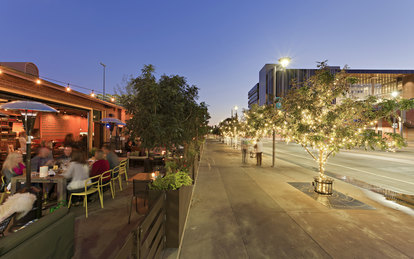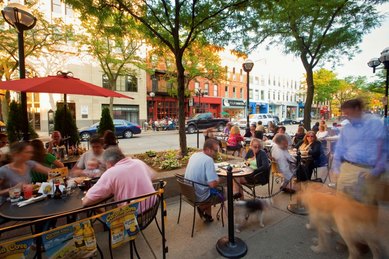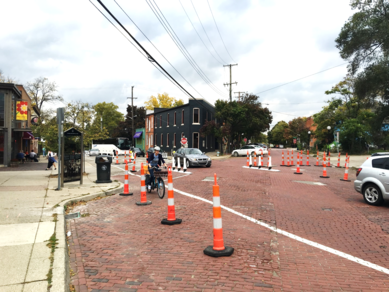改善街道和公共领域以建立弹性社区

For many decades, the primary motivation of streetscape design was to make traditional main streets look fresh while enhancing their historic character and competitiveness relative to suburban shopping areas. Over time, best practices and design trends coalesced around the placemaking concept, alongside broader recognition that creating comfortable, attractive places did in fact add to economic vitality, community identity and quality of life.
Critical to placemaking – though often not discussed enough – is the vital role that streets and related infrastructure play in making our communities safe, accessible and resilient. Streets can comprise upwards of twenty-five percent (or more!) of urban land areas. Streets and public rights-of-way are the principle spaces in which we move through and experience our communities.
Instead of designing streetscapes primarily as a cosmetic improvement we are now designing streets more holistically, thinking about the entire street corridor and environment. Designers and city leaders must ask how all different modes of travel and people are accommodated, how adjacent land uses are respected and connected, and how streets enhance community sustainability and resiliency as well as aesthetics.
As defined by the Rockefeller Center 100 Resilient Cities program (soon to be reborn as the Global Resilient Cities Network), “Resilience is the capacity to prepare for disruptions, recover from shocks and stresses, and adapt and grow from a disruptive experience.” When you look at streets through the lens of community resiliency, a much broader range of values and opportunities for affecting positive changes emerge.
The global experience with the COVID-19 crisis highlights the three actions of this definition that ring true: prepare, recover and adapt. The role of well-designed streets in creating resilient communities is a critical piece of what planning, design and engineering professionals can contribute to before and during times of crisis and beyond.
We believe resilient street design must aspire to advance these key design drivers:
Ensure equity for the vulnerable members of a community, which are the people most impacted by crises, disruptions and legacy disinvestment. Infrastructure improvements must plan for the most vulnerable in the community by providing access to traditionally underserved neighborhoods, engaging all members of the community, and providing safe and efficient access to recreation, jobs and civic amenities. We must recognize that achieving equitable outcomes benefits all of society and is inherently impacted by how we design the public realm.
Build streets that adapt to evolving use patterns and systemic stress. Street design must accommodate multi-modal users of all ages and abilities and be flexible enough to adapt to evolving mixes of land use and activity. Resilient streets can better support civic activities, promote a stronger business environment, and build community through unique opportunities for interaction and exchange.
Manage carbon emissions to increase sustainability and reduce disruptive impacts to the environment and human health. Encouraging a reduction in energy use, transferring to renewable energy sources, and increasing walking, biking and mass transit ridership over the use of personal motor vehicles are key mobility shifts that well-designed streets can support and encourage.
Support human health and wellness by providing and increasing access to recreation and outdoors, reducing exposure to pollution and environmental stress, and improving safety for all street users – especially for pedestrians and cyclists who are at the greatest risk of severe injury. Sheltering in place for COVID-19 has dramatically reduced urban air pollution around the globe, highlighting the gains that could be realized through a concerted commitment to carbon reduction. The link between air pollution and the potential deadliness of the disease should also serve as a wake-up call to the ways we are building health risks into our infrastructure systems.
Build more sustainable downtowns and mixed-use districts by reducing the impacts of the urban heat island, managing extreme storm events and flooding, and building stronger and more flexible infrastructure systems.
The COVID-19 crisis has created motivation to make our streets and public spaces more resilient. Municipal leaders we’ve talked to – and others across the country - are sharing similar thoughts, concerns and creative ideas to mitigate the worst impacts of the pandemic while positioning their communities for greater resiliency in the future. Their perspectives include the following:
- A realization that a return to “normal” will be gradual and that the future will undoubtedly be different than the normal of the past. This crisis is an opportunity to rethink how we design for and balance the needs of street users and business owners.
- Transportation and infrastructure systems are critical during times of crisis and continued investment in them is necessary for health, safety and economic reasons. This is a good time to position projects for federal stimulus funding – especially as municipal budgets are challenged by economic downtowns.
- Demand for walking and biking space that allows for better physical distancing is increasing everywhere. Parks, greenways, sidewalks and bike lanes are often overloaded, pushing people into adjacent streets to maintain safe distances. This is the time to adapt streets and design them for flexibility, allowing for more rapid adjustments when needed.
- The need for long-term street parking is decreasing in commercial core areas, while the demand for curbside drop-off and pick-up is increasing. This preview of how streets are more likely to function as autonomous vehicle adoption moves forward could help guide larger transitional strategies for future street design.
- Downtowns and business districts need creative and agile responses to help weather this crisis. This is an opportunity to implement quick, low-cost interventions that build incrementally towards long-term improvements.
- The stay-at-home requirements across the country have heightened our awareness that we are social beings in need of a community to thrive. We must design and program streets and public spaces to safely support community cohesion before, during and following times of crisis.
How can design professionals help achieve the above? Many communities are pursuing temporary measures to reassign the use of street rights-of-way. Tactical urbanism approaches can take advantage of reduced vehicular traffic volumes to creatively enable the testing of ideas, some of which may be temporary and others which may inform long-term changes to street design. These ideas, which we and our partners are exploring, include:
- Filling in gaps in urban bike networks, better linking neighborhoods and regional trails to commercial areas.
- Creating separated bike facilities on key routes into and through downtowns and business districts.
- Using parking spaces and street lanes to increase the effective sidewalk width while creating expanded space for activities such as outdoor dining and outdoor retail.
- Eliminating vehicles intermittently from key blocks to allow for more dispersed outdoor dining, events, activities and non-motorized travel.
- Collaborating on new programs and events that support wellness, equity and business vitality.
- Allowing for the re-purposing parking spaces for more flexible uses, including service and delivery, pick-up/drop-off and transit.
This challenging and tragic moment provides an opportunity to advance the philosophy of 100 Resilient Cities and “adapt and grow from a disruptive experience.” It is an opportunity to think deeply about creative and positive ways to address the current crisis while simultaneously building the capacity needed to prepare for disruptions that will undoubtedly occur in the years ahead.
While the future is difficult to predict, we can embrace this uncertainty and pursue resilient design changes that let us better respond to and thrive in whatever future comes next.


